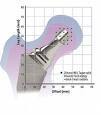by
Joan Trombetti, Writer | August 19, 2008

New hip replacement
implant designed to cater
to women’s needs
When it comes to hips and joints, one size is not right for all, and women facing hip surgery are being offered a new option specifically designed with their anatomy in mind. At Rush University Medical Center, orthopedic surgeons are offering a new "gender-specific" implant called the M/L Taper Hip Prosthesis with Kinectiv™ Technology.
Dr. Richard Berger, an orthopedic surgeon at Rush, helped design the new hip replacement made by Zimmer, Inc.
"The traditional artificial hip is based on a man's anatomy. Women are built differently than men," said Berger. "Women tend to be shorter than men, more petite and have smaller bones and shorter hips."



Ad Statistics
Times Displayed: 2157
Times Visited: 29 Keep biomedical devices ready to go, so care teams can be ready to care for patients. GE HealthCare’s ReadySee™ helps overcome frustrations due to lack of network and device visibility, manual troubleshooting, and downtime.
That is why when doctors use a conventional hip replacement implant, they need to make adjustments during surgery with results that are not always perfect for women as well as men whose height is 5 feet 5 inches or shorter. In some cases, the stem of the implant, which is the part that fits inside the upper thigh bone may be too long and can cause the hip to push out and the leg to be slightly longer than normal.
The stress from the mismatch can cause the new hip to fail or lead to significant pain and disability, requiring another replacement.
Gender-specific pieces give surgeons more options to work with. Surgeons measure the hip bones during the operation in order to pick the size that most resembles the natural bone.
The gender-specific hip implant comes in three separate sections: a stem, the head and the neck, so it is adjustable for a woman's size and shape. During the surgery, all three sections are connected. The pieces lock in place but can be changed at anytime. Now, orthopedic surgeons can fine tune and adjust according to the patient's leg length, muscle tension and hip stability.
Another advantage of the gender-specific hip is that it is minimally invasive surgery and only requires small incisions to place each of the separate components. Because there is no need to cut through muscles and tendons, the recovery time is significantly reduced.
Berger and Dr. Aaron Rosenberg, an orthopedic surgeon at Rush, also helped design the first high-flex knee replacement implant shaped specifically to fit a woman's anatomy.The implant addresses the shape-related differences typical of a woman's knee: a narrower shape; thinner shape, and the need for more natural motion for the knee when walking.
Joint stability and range of motion are critical factors for patients in need of a hip or knee replacement and a proper fit is crucial for a successful hip or knee implant," said Berger. "The availability of implants in a wide variety of shapes and sizes will help us provide a more patient-specific approach for all patients."
For more information on orthopedics at Rush, http://www.rush.edu/rumc/page-R11726.html
Rush University Medical Center is an academic medical center that encompasses the more than 600 staffed-bed hospital (including Rush Children's Hospital), the Johnston R. Bowman Health Center and Rush University. Rush University, with more than 1,270 students, is home to one of the first medical schools in the Midwest, and one of the nation's top-ranked nursing colleges. Rush University also offers graduate programs in allied health and the basic sciences. Rush is noted for bringing together clinical care and research to address major health problems, including arthritis and orthopedic disorders, cancer, heart disease, mental illness, neurological disorders and diseases associated with aging.

